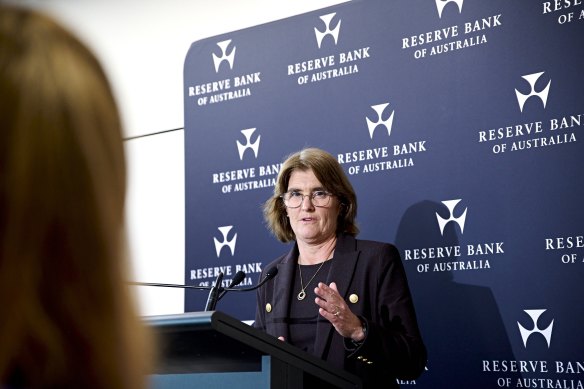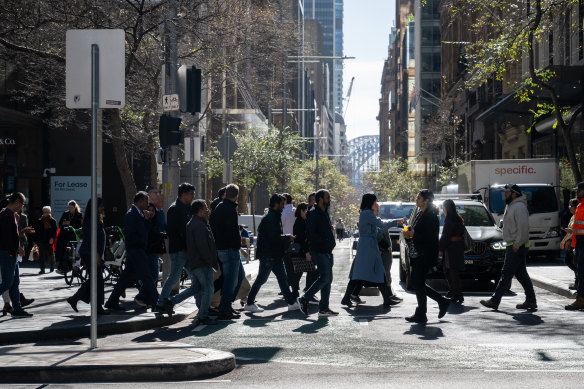Opinion
There’s a good case for cutting interest rates ASAP
Ross Gittins
Economics EditorWhat a difference a number makes. For weeks, the money market’s macho men had been telling us interest rates needed to rise yet further to ensure inflation would keep falling. But last week, their case went up in smoke and now almost no one thinks the Reserve Bank board will do anything at its two-day meeting starting today.
The weeks of idle speculation came to an end when finally we saw the consumer price index for the June quarter. It showed underlying inflation falling to 3.9 per cent.

There’s little chance the Reserve Bank, led by governor Michele Bullock, will move interest rates this week.Credit: Michael Quelch
So, sighs of relief all round. But why had we allowed these misguided souls to cause us so much angst? Why had their intimations of death and destruction been given so much air time?
Short answer: because we find bad news more interesting than good news. But as last week’s abrupt turnaround reminds us, the bad news ain’t necessarily so. So maybe we should give a hearing to those urging the Reserve to do something nice rather than nasty.
Let me tell you about a briefing note from the economists at the Australian Council of Social Service, who remind the Reserve that its much-remarked “narrow path” to lower inflation without triggering a recession and high unemployment is narrow “because it’s rare for interest rate hikes of this scale and intensity not to trigger a serious economic downturn”.
The peak welfare organisation says the process of reducing demand and lowering inflation is already well under way and, since increases in official interest rates take up to two years to flow through to inflation and unemployment, it has called for the Reserve to start reducing interest rates immediately.
Those who focus on the slowdown in the fall of the inflation rate and conclude there’s a need for further tightening have failed to see how sharply job opportunities and living standards have fallen, even without a recession.
The council examines the data for the two years since the Reserve began increasing interest rates, from June 2022 to June 2024, and it finds a lot more evidence of downturn and pain than you may realise.
For a start, the number of vacancies for entry-level jobs has declined by almost a third. There are an additional 100,000 people unemployed, and almost as many extra people suffering underemployment (unable to find as many hours of work as they want).
If you know employment is still growing, get this: this has occurred only because of stronger growth in publicly funded jobs (particularly under the National Disability Insurance Scheme). The annual number of publicly funded jobs has grown from 210,000 to 326,000, whereas jobs growth in the market sector has collapsed from 321,000 a year to 6000 a year.
If interest rates stay high, jobs in the market sector are likely to decline, but the present growth in publicly funded jobs won’t last.

Jobs growth in the market sector has collapsed since the RBA started raising interest rates.Credit: Louie Douvis
We have avoided a recession – an economy that’s getting smaller – so far only because of the surprisingly strong bounce-back in immigration since the reopening of our borders. This won’t continue.
But the real value of goods and services produced per person has been falling, meaning that living standards have been falling. Over the two years, average real income per person has fallen by 8 per cent, or about $5000 a year.
According to the council’s calculations, the stage 3 tax cuts, the energy rebate and increased rent allowance for people on pensions or benefits announced in the May budget will restore only about a fifth of this loss of real income to households.
So the macho men’s fear that the budget measures will add to inflation pressure is laughable. And the council doesn’t miss the opportunity to remind us that JobSeeker unemployment benefits remain a miserly $55 a day.
As for the macho men’s fear that a “price-wage spiral” could take off at any moment, the council says average wages have fallen by 2 per cent since June 2022, after adjusting for inflation.
Wages have started rising a fraction faster than inflation, but it will take many moons to make up that gap. Meanwhile, the collapse in consumer spending has been “precipitous”: a fall of 10 per cent in real spending per person since June 2022.
If the Reserve’s renewed commitment to maintaining full employment is to have any meaning, it will need to start cutting the official interest rate ASAP.
Ross Gittins unpacks the economy in an exclusive subscriber-only newsletter every Tuesday evening. Sign up to receive it here.